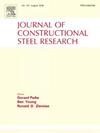Topology optimisation of double-layer grid structures with stability constraints
IF 4
2区 工程技术
Q1 CONSTRUCTION & BUILDING TECHNOLOGY
引用次数: 0
Abstract
Grid structures are widely employed in civil engineering due to their outstanding strength-to-weight ratio and ability to span long distances. However, their shallow structural depth and slender members render them susceptible to buckling failures under significant moments or compression forces. One under-explored approach to addressing this issue is the strategic addition of structural members as a second layer to a base grid. This paper tackles the challenge of identifying optimal member layouts in double-layer grid structures, through a density-based topology optimisation problem. In this approach, candidate members, arranged in-plane and out-of-plane with respect to the base structures, are considered as design variables. The problem is formulated based on the Solid Isotropic Material with Penalisation (SIMP) method to minimise compliance while satisfying constraints related to material volume and structural stability. To address stability concerns, linear buckling loads derived from an eigenvalue analysis are employed as constraints. To diversify optimisation results, regions with dense material distribution are split using local material constraints at the element level. The efficacy of this methodology is tested on a double-layer elliptic paraboloid grid shell with a square on-plan projection subject to a uniformly distributed vertical load. The stability characteristics of the optimal structures are further evaluated through geometric non-linear analysis. A comparative analysis of static compliance and non-linear critical loads under various external loads reveals that structures optimised with high stability limits and local material constraints generally exhibit enhanced robustness, characterised by improved stability and stiffness. Additionally, the versatility of the method is showcased through its application to a composite hyperbolic paraboloid grid shells featuring diverse mesh configurations.
求助全文
约1分钟内获得全文
求助全文
来源期刊

Journal of Constructional Steel Research
工程技术-工程:土木
CiteScore
7.90
自引率
19.50%
发文量
550
审稿时长
46 days
期刊介绍:
The Journal of Constructional Steel Research provides an international forum for the presentation and discussion of the latest developments in structural steel research and their applications. It is aimed not only at researchers but also at those likely to be most affected by research results, i.e. designers and fabricators. Original papers of a high standard dealing with all aspects of steel research including theoretical and experimental research on elements, assemblages, connection and material properties are considered for publication.
 求助内容:
求助内容: 应助结果提醒方式:
应助结果提醒方式:


